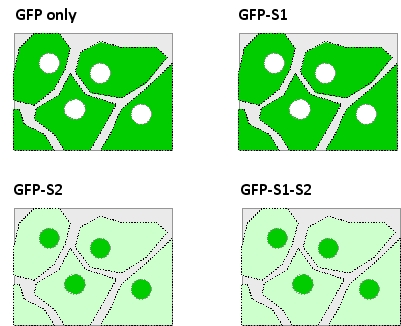Two segments (S1 and S2) in a viral protein are suspected to be responsible for the nuclear localization of the protein in infected human cells. You have engineered a plasmid to encode the green fluorescent protein (GFP) fused to either or both of these peptide segments, and have introduced the plasmid into the cells. After the expression of the fusion protein is induced, you visualize the cells using a fluorescence microscope equipped with filters appropriate for detection of GFP. Your results are presented in the following schematic drawings in which the GFP signal is represented in green. Which of the following is more consistent with these observations? 
A) Both S1 and S2 are required for nuclear localization.
B) S1 is required and sufficient for nuclear localization.
C) S2 is required and sufficient for nuclear localization.
D) S1 is required but not sufficient for nuclear localization.
E) S2 is required but not sufficient for nuclear localization.
Correct Answer:
Verified
Q5: The following schematic diagram shows the path
Q6: Single-molecule detection by fluorescence microscopy is limited
Q7: If an average globular protein was of
Q8: Consider an engineered chimeric protein made from
Q9: Two approaches have been devised to deal
Q11: What is the advantage of using quantum
Q12: Given the absorption and emission spectra of
Q13: Which microscopy set-up uses a longer wavelength
Q14: Atomic force microscopy (AFM) is used in
Q15: A certain GTP-binding protein can exist in
Unlock this Answer For Free Now!
View this answer and more for free by performing one of the following actions

Scan the QR code to install the App and get 2 free unlocks

Unlock quizzes for free by uploading documents